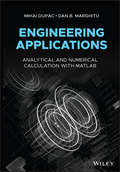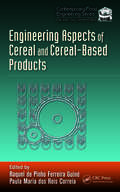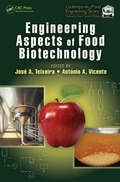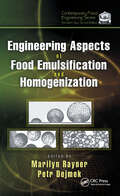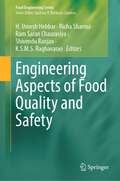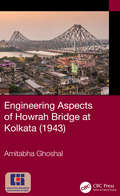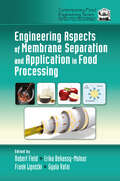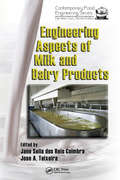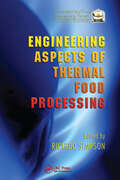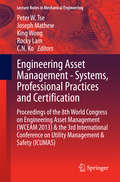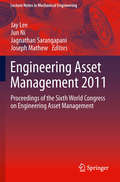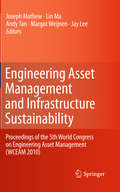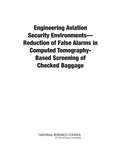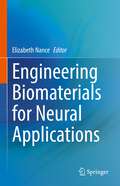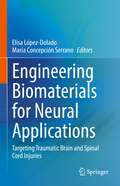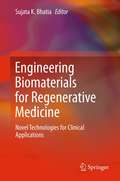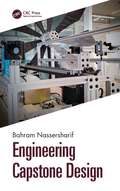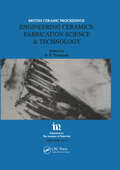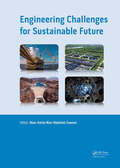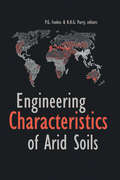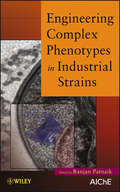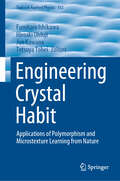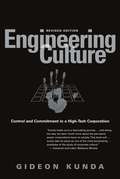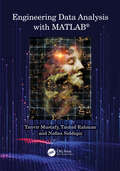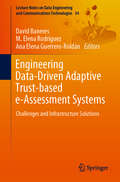- Table View
- List View
Engineering Applications: Analytical and Numerical Calculation with MATLAB
by Mihai Dupac Dan B. MarghituA comprehensive text on the fundamental principles of mechanical engineering Engineering Applications presents a comprehensive text to the fundamental principles and applications of the statics and mechanics of materials in the design of complex mechanical systems. The book uses the modern tool of MATLAB to help solve problems with numerical and analytical calculations. The authors—noted experts on the topic—offer an understanding of the static behaviour of engineering structures and components considering the mechanics of materials knowledge as an essential part (most important) for their design. The authors explore the concepts, derivations and interpretations of the general principles and discuss the creation of mathematical models and the formulation of the mathematical equations. The practical text highlights the solutions of the problems that are solved analytically and numerically using MATLAB. The figures generated with MATLAB reinforce visual learning for students (and professionals) as they study the programs. This important text: • Shows how mechanical principles are applied to engineering design • Covers basic material with both mathematical and physical insight • Provides an understanding of classical mechanical principles • Offers the modern tool of MATLAB to solve problems • Helps to reinforce learning using visual and computational techniques Written for students and professional mechanical engineers, Engineering Applications helps hone reasoning skills in order to interpret data, generate mathematical equations and learn different methods of solving them for evaluating and designing engineering systems.
Engineering Aspects of Cereal and Cereal-Based Products (Contemporary Food Engineering #28)
by Raquel de Pinho Ferreira Guiné Paula Maria dos Reis CorreiaCereal food engineering has become increasingly important in the food industry over the years, as it plays a key role in developing new food products and improved manufacturing processes. Engineering Aspects of Cereal and Cereal-Based Products focuses on the recent growth in cereal technology and baked foods science, reviewing the latest updates in
Engineering Aspects of Food Biotechnology (Contemporary Food Engineering)
by António A. Vicente José A. TeixeiraFood biotechnology's typical developments and applications have occurred in the fields of genetics and in enzyme- and cell-based biological processes, with the goal of producing and improving food ingredients and foods themselves. While these developments and applications are usually well reported in terms of the underlying science, there is a clea
Engineering Aspects of Food Emulsification and Homogenization (Contemporary Food Engineering Ser.)
by Marilyn Rayner Petr DejmekEmulsions are found in a wide variety of food products, pharmaceuticals, paints, and cosmetics, thus emulsification is a truly multidisciplinary phenomenon. Therefore understanding of the process must evolve from the combination of (at least) three different scientific specializations. Engineering Aspects of Food Emulsification and Homogenization d
Engineering Aspects of Food Quality and Safety (Food Engineering Series)
by Shivendu Ranjan H. Umesh Hebbar Richa Sharma Ram Saran Chaurasiya K. S. M. S. RaghavaraoEngineering Aspects of Food Quality and Safety aims to fill the knowledge gap in current technological advances and methods for food safety and quality, dedicating entire sections to analytical techniques from quality testing to packaging, post-harvest methods from product utilization to storage to chemical engineering principles and pre-harvest interventions from genetic engineering and mechanization to the links between pre-and-post harvest techniques. Throughout the book, global policy perspectives are taken into account. An introductory section is also included to cover the role of food processing and engineering in food quality and safety improvement. Encompassing all of the major applications and challenges involved in the engineering aspects of food safety and quality in one source, this work is incredibly valuable to a wide range of food engineers, scientists, and industry professionals involved in the engineering, processing and packaging of both novel and traditional foods. This text provides a detailed overview of the newest methods and advanced technologies used in the improvement of quality and safety in foods. The processes and methods described in this book are applicable to many areas of the food industry including pre-harvest and post-harvest technology, food machinery and product formulation. Featuring contributions from prominent food scientists and engineers across the globe, this work contains detailed coverage of the latest advances in genetic and chemical engineering, mechanization, thermal and non-thermal processing, automation, computational tools, packaging and waste management. The latest analytical techniques are also covered, including chapters dedicated to in-line monitoring, nanosensors, rapid testing kits and E-sensors. Maintaining a high standard of safety for consumers in foods is an interdisciplinary effort involving biologists, chemists, nutritionists, chemical engineers, mechanical engineers and genetic engineers among others. All of these experts will find this book to be a singular source encompassing all of the major current advances in food safety engineering and processing.
Engineering Aspects of Howrah Bridge at Kolkata (1943)
by Amitabha GhoshalHowrah Bridge is an iconic engineering structure of Kolkata (formerly Calcutta) and is in excellent condition after 78 years of extensive use. The bridge is a balanced cantilever structure, has a central span of 457 meters, used 26,500 tons of high-grade steel and was entirely fabricated at Kolkata to a high precision as a riveted structure. The bridge is an example of the high-quality work that went into bridge building in earlier years and offers unique design and detailing features. This current book covers all the engineering aspects of the structure explaining planning, design of superstructures, substructures and foundations along with fabrication and erection with a separate section on special features. Aimed at civil and bridge engineering students and graduate engineers, professionals, practicing structural engineers and also heritage structure enthusiasts, this book offers a detailed case study and a thorough description of a well-known and iconic bridge. It covers the planning process to design and construction aspects. It discusses conceptual design aspects and alternatives considered at the time of construction. It explains the planning of the foundations in a clayey silt river bed, subject to tidal variations, the design and construction of foundations, and illustrates the fabrication of steel work and the use of pre-cambering principle.
Engineering Aspects of Membrane Separation and Application in Food Processing (Contemporary Food Engineering)
by Robert Field, Erika Bekassy-Molnar, Frank Lipnizki, and Gyula VataiEngineering Aspects of Membrane Separation and Application in Food Processing presents an overview and introduction to a wide range of membrane processes, their unique characteristics and challenges. In the food industry, as in many industries, membranes have an environmental advantage over conventional processes that they displace, because they are less energy intensive. The processing at near-ambient conditions also retains flavors and nutritional value. These advantages, together with significant reductions in the cost of membrane modules, augers well for their future not only in the dairy industry but in other parts of the food industry, such as alcohol processing, animal product processing, and fruit and vegetable processing. Chapters address a wide range of membranes separations in the food and beverage industries, and applications are provided that will be of value not only to food engineers but also to process engineers working in other areas. The processing of food is now a highly interdisciplinary science, and anyone concerned with food processing will benefit from reading this book and understanding what membrane processes of the twenty-first century have to offer.
Engineering Aspects of Milk and Dairy Products (Contemporary Food Engineering)
by José A. Teixeira Jane Sèlia dos Reis CoimbraExpert Insight into the Engineering Aspects of Dairy Products ManufacturingConsumer demand is constantly on the rise for better and more nutritious dairy products, from traditional milk to new, high-value added products like meal-replacement drinks. This changing market preference reinforces the importance of milk as a raw material in the food indu
Engineering Aspects of Thermal Food Processing
by Ricardo SimpsonAccess the Latest Advances in Food Quality Optimization and Safety AssuranceThermal processing has undergone a remarkable amount of research throughout the past decade, indicating that the process not only remains viable, but that it is also expanding around the world.An organized exploration of new developments in academic and current food industr
Engineering Asset Management - Systems, Professional Practices and Certification
by Joseph Mathew Peter W. Tse King Wong Rocky Lam C. N. KoThis proceeding represents state-of-the-art trends and developments in the emerging field of engineering asset management as presented at the Eight World Congress on Engineering Asset Management (WCEAM). The Proceedings of the WCEAM 2013 is an excellent reference for practitioners, researchers and students in the multidisciplinary field of asset management, covering topics such as: Asset condition monitoring and intelligent maintenance, 2. Asset data warehousing, data mining and fusion, 3. Asset performance and level-of-service models, 4. Design and life-cycle integrity of physical assets, 5. Deterioration and preservation models for assets, 6. Education and training in asset management, 7. Engineering standards in asset management, 8. Fault diagnosis and prognostics, 9. Financial analysis methods for physical assets, 10. Human dimensions in integrated asset management, 11. Information quality management, 12. Information systems and knowledge management, 13. Intelligent sensors and devices, 14. Maintenance strategies in asset management, 15. Optimisation decisions in asset management, 16. Risk management in asset management, 17. Strategic asset management, 18. Sustainability in asset management. King WONG served as Congress Chair for WCEAM 2013 and ICUMAS 2013 is the President of the Hong Kong Institute of Utility Specialists (HKIUS) and Convener of International Institute of Utility Specialists (IIUS). Peter TSE is the Director of the Smart Engineering Asset Management laboratory (SEAM) at the City University of Hong Kong and served as the Chair of WCEAM 2013 Organising Committee. Joseph MATHEW served as the Co-Chair of WCEAM 2013 is also WCEAM's General Chair. He is the Chief Executive Officer of Asset Institute, Australia.
Engineering Asset Management 2011: Proceedings of the Sixth World Congress on Engineering Asset Management
by Joseph Mathew Jay Lee Jagnathan Sarangapani Jun NiThis text represents state-of-the-art trends and developments in the emerging field of engineering asset management as presented at the Sixth World Congress on Engineering Asset Management (WCEAM) held in Cincinnati, OH, USA from October 3-5, 2011 The Proceedings of the WCEAM 2011 is an excellent reference for practitioners, researchers and students in the multidisciplinary field of asset management, covering topics such as: Asset condition monitoring and intelligent maintenance; Asset data warehousing, data mining and fusion; Asset performance and level-of-service models; Design and lifecycle integrity of physical assets; Deterioration and preservation models for assets; Education and training in asset management; Engineering standards in asset management; Fault diagnosis and prognostics; Financial analysis methods for physical assets; Human dimensions in integrated asset management; Information quality management; Information systems and knowledge management; Intelligent maintenance; Intelligent sensors and devices; Maintenance strategies in asset management; Optimization decisions in asset management; Prognostics & Health Management; Risk management in asset management; Strategic asset management; and Sustainability in asset management.
Engineering Asset Management and Infrastructure Sustainability
by Lin Ma Andy Tan Joseph Mathew Jay Lee Margot WeijnenEngineering Asset Management 2010 represents state-of-the art trends and developments in the emerging field of engineering asset management as presented at the Fifth World Congress on Engineering Asset Management (WCEAM). The proceedings of the WCEAM 2010 is an excellent reference for practitioners, researchers and students in the multidisciplinary field of asset management, covering topics such as: Asset condition monitoring and intelligent maintenanceAsset data warehousing, data mining and fusionAsset performance and level-of-service modelsDesign and life-cycle integrity of physical assetsEducation and training in asset managementEngineering standards in asset managementFault diagnosis and prognosticsFinancial analysis methods for physical assetsHuman dimensions in integrated asset managementInformation quality managementInformation systems and knowledge managementIntelligent sensors and devicesMaintenance strategies in asset managementOptimisation decisions in asset managementRisk management in asset managementStrategic asset managementSustainability in asset management
Engineering Aviation Security Environments--Reduction of False Alarms in Computed Tomography-Based Screening of Checked Baggage
by National Research Council Division on Engineering and Physical Sciences Committee on Engineering Aviation Security Environments--False Positives from Explosive Detection Systems National Materials and Manufacturing BoardOn November 19, 2001 the Transportation Security Administration (TSA) was created as a separate entity within the U.S. Department of Transportation through the Aviation and Transportation Security Act. The act also mandated that all checked baggage on U.S. flights be scanned by explosive detection systems (EDSs) for the presence of threats. These systems needed to be deployed quickly and universally, but could not be made available everywhere. As a result the TSA emphasized the procurement and installation of certified systems where EDSs were not yet available. Computer tomography (CT)-based systems became the certified method or place-holder for EDSs. CT systems cannot detect explosives but instead create images of potential threats that can be compared to criteria to determine if they are real threats. The TSA has placed a great emphasis on high level detections in order to slow false negatives or missed detections. As a result there is abundance in false positives or false alarms. In order to get a better handle on these false positives the National Research Council (NRC) was asked to examine the technology of current aviation-security EDSs and false positives produced by this equipment. The ad hoc committee assigned to this task examined and evaluated the cases of false positives in the EDSs, assessed the impact of false positive resolution on personnel and resource allocation, and made recommendations on investigating false positives without increase false negatives. To complete their task the committee held four meetings in which they observed security measures at the San Francisco International Airport, heard from employees of DHS and the TSA. Engineering Aviation Security Environments--Reduction of False Alarms in Computed Tomography-Based Screening of Checked Baggage is the result of the committee's investigation. The report includes key conclusions and findings, an overview of EDSs, and recommendations made by the committee.
Engineering Biomaterials for Neural Applications
by Elizabeth NanceThis contributed volume explores the ways in which researchers engineer new biomaterials for the challenging problems of the peripheral and central nervous systems. These biomaterials are uniquely positioned for use in creating in vitro models of injury and disease, testing therapeutic treatments, understanding neural development, and mapping the multi-scalar environment of the brain. This book informs readers from biology, chemistry, materials science, engineering, and neuroscience on cutting edge research in engineering technologies, from fundamental material development through pre-clinical studies. The book also highlights target applications in three areas of research: (1) engineering neural models and materials, (2) probing biological underpinnings of neurological function and disease, and (3) designing therapeutic and diagnostic treatments for neurological disease.
Engineering Biomaterials for Neural Applications: Targeting Traumatic Brain and Spinal Cord Injuries
by Elisa López-Dolado María Concepción SerranoThis book describes past and present advances in engineering materials for neural applications, with special emphasis on their usefulness for traumatic brain and spinal cord injuries. The book presents major physio-pathological features of traumatic injuries at the brain and spinal cord as examples of diseases hampering the central nervous tissue. By incorporating knowledge from the perspective of experts with diverse backgrounds, this book gives insight into the understanding of these multifaceted pathologies and the materials science approaches that aim to cure them. The interdisciplinary nature of this book makes it a perfect candidate for the interest of a broad audience, from clinicians working on neural diseases to scientists whose work focuses on the nervous tissue (neuroscientists) and/or materials science. Undergraduate and PhD students can also benefit from the knowledge and discussion included in this book.
Engineering Biomaterials for Regenerative Medicine
by Sujata K. BhatiaRegeneration of tissues and organs remains one of the great challenges of clinical medicine, and physicians are constantly seeking better methods for tissue repair and replacement. Tissue engineering and regenerative medicine have been investigated for virtually every organ system in the human body, and progress is made possible by advances in materials science, polymer chemistry, and molecular biology. This book reviews the current status of biomaterials for regenerative medicine, and highlights advances in both basic science and clinical practice. The latest methods for regulating the biological and chemical composition of biomaterials are described, together with techniques for modulating mechanical properties of engineered constructs. Contributors delineate methods for guiding the host response to implantable materials, and explain the use of biologically-inspired materials for optimal biological functionality and compatibility. The book culminates in a discussion of the clinical applications of regenerative medicine. By integrating engineering and clinical medicine, Engineering Biomaterials for Regenerative Medicine examines how tissue engineering and regenerative medicine can be translated into successful therapies to bridge the gap between laboratory and clinic. The book will aid materials scientists and engineers in identifying research priorities to fulfill clinical needs, and will also enable physicians to understand novel biomaterials that are emerging in the clinic. This integrated approach also gives engineering students a sense of the excitement and relevance of materials science in the development of novel therapeutic strategies.
Engineering Capstone Design
by Bahram NassersharifStructured with a practical approach, Engineering Capstone Design guides engineering students to successfully manage capstone design projects. The book addresses the challenge of open-ended design projects, often in a team-based format, discussing team member roles, communication, and cooperation. It incorporates accreditation requirements and provides a modern framework for working with industry, reinforced by the inclusion of case studies. Offers a structured process for capstone design, responsive to ABET accreditation requirements Explains how to manage design projects under critical timelines and budgets Covers essential topics and steps in a capstone design sequence, including defining, conceiving, presenting, prototyping, building, testing, and redesigning Considers industry perspectives, as well as design competitions Includes case studies for a look into industry experience In addition to guiding engineering students conducting capstone design projects, this book will also interest industry professionals who are engaged in product development or design problem-solving.
Engineering Ceramics: Fabrication Science and Technology
by D.P. ThompsonThis 50th volume in the British Ceramics Proceedings series includes papers presented at a meeting of the Basic Science Section held in Manchester, UK in December 1991.
Engineering Challenges for Sustainable Future: Proceedings of the 3rd International Conference on Civil, Offshore and Environmental Engineering (ICCOEE 2016, Malaysia, 15-17 Aug 2016)
by Noor Amila Wan Abdullah ZawawiEngineering Challenges for Sustainable Future contains the papers presented at the 3rd International Conference on Civil, Offshore & Environmental Engineering (ICCOEE2016, Kuala Lumpur, Malaysia, 15-17 August 2016), under the banner of World Engineering, Science & Technology Congress (ESTCON2016). The ICCOEE series of conferences started in Kuala Lumpur, Malaysia 2012, and the second event of the series took place in Kuala Lumpur, Malaysia 2014. This conference series deals with the civil, offshore & environmental engineering field, addressing the following topics:• Environmental and Water Resources Engineering• Coastal and Offshore Engineering• Structures and Materials• Construction and Project Management• Highway, Geotechnical and Transportation Engineering and Geo-informatics This book is an essential reading for academic, engineers and all professionals involved in the area of civil, offshore and environmental engineering.
Engineering Characteristics of Arid Soils
by P.G. Fookes and R.H.G. ParrySoils formed or now existing under arid climatic conditions cover more than one-third of the world's land surface. Many have unique characteristics which can pose difficult geotechnical problems. This text considers these problems and suggests ways of overcoming them.
Engineering Complex Phenotypes in Industrial Strains
by Ranjan PatnaikThis book highlights current trends and developments in the area of engineering strains. The book details the current and future tools used in the production of bulk chemicals and biofuels from renewable biomass using green technologies. Complex phenotypes are traits in a microbe that requires multiple genetic changes to be modulated simultaneously in the microorganism's DNA. Knowing what those genetic changes are for a given trait and how to make those changes in the most efficient way forms the motivation behind writing this book. This book explains the newer tools to develop and enable engineered strains at time scales much faster that the natural evolution process so that we can increase a cells' production of a certain substance, increase process productivity, and extend metabolic capability. This book provides a one stop platform of reference for practicing researchers in the field of industrial biotechnology. This book also explains that the commercial success of a process that uses microbial catalysts over platforms that use chemical catalysts and fossil fuels depends on the time it takes to engineer these microbes to perform the desired reaction under harsh manufacturing conditions and at rates that meets the criteria for economic feasibility.
Engineering Crystal Habit: Applications of Polymorphism and Microstexture Learning from Nature (Topics in Applied Physics #152)
by Fumitaro Ishikawa Hiroaki Ohfuji Jun Kawano Tetsuya ToheiThis book compiles reviews of both fundamental and applied research in physics and materials science, focusing on the existence, formation mechanisms, and artificial synthesis of versatile, nature-inspired crystals. It aims to highlight the development and application of advanced crystals with novel polymorphism and microtextures, resulting in the innovation of completely new and unexpected functionality. The book encompasses five main topics; the first three focus on fundamental research in mineralogy in the areas of polymorphism and microtexture in biological environments, crystallographic structure, and nucleation and growth. The last two parts address applied research devoted to microtexture and polymorphism in electronics and photonics applications. The featured topics comprise contributions from international groups of active researchers in the field. The book is a valuable tool for a wide readership ranging from graduate students to researchers and engineers. The broad coverage of topics is attractive to readers from diverse fields including crystal engineering, drug development, electronic materials, electronic devices, and mineralogy.
Engineering Culture: Control and Commitment in a High-Tech Corporation
by Gideon KundaEngineering Culture is an award-winning ethnography of the engineering division of a large American high-tech corporation. Now, this influential book—which has been translated into Japanese, Italian, and Hebrew—has been revised to bring it up to date. In Engineering Culture, Gideon Kunda offers a critical analysis of an American company's well-known and widely emulated "corporate culture. " Kunda uses detailed descriptions of everyday interactions and rituals in which the culture is brought to life, excerpts from in-depth interviews and a wide variety of corporate texts to vividly portray managerial attempts to design and impose the culture and the ways in which it is experienced by members of the organization. The company's management, Kunda reveals, uses a variety of methods to promulgate what it claims is a non-authoritarian, informal, and flexible work environment that enhances and rewards individual commitment, initiative, and creativity while promoting personal growth. The author demonstrates, however, that these pervasive efforts mask an elaborate and subtle form of normative control in which the members' minds and hearts become the target of corporate influence. Kunda carefully dissects the impact this form of control has on employees' work behavior and on their sense of self. In the conclusion written especially for this edition, Kunda reviews the company's fortunes in the years that followed publication of the first edition, reevaluates the arguments in the book, and explores the relevance of corporate culture and its management today.
Engineering Data Analysis with MATLAB®
by Tanvir Mustafy Tauhid Rahman Nafisa SiddiquiThis book provides a concise overview of a variety of techniques for analyzing statistical, scientific, and financial data, using MATLAB® to integrate several approaches to data analysis and statistics. The chapters offer a broad review of computational data analysis, illustrated with many examples and applications. Topics range from the basics of data and statistical analysis to more advanced subjects such as probability distributions, descriptive and inferential statistics, parametric and non-parametric tests, correlation, and regression analysis. Each chapter combines theoretical concepts with practical MATLAB® applications and includes practice exercises, ensuring a comprehensive understanding of the material. With coverage of both basic and more complex ideas in applied statistics, the book has broad appeal for undergraduate students up to practicing engineers.
Engineering Data-Driven Adaptive Trust-based e-Assessment Systems: Challenges and Infrastructure Solutions (Lecture Notes on Data Engineering and Communications Technologies #34)
by David Baneres M. Elena Rodríguez Ana Elena Guerrero-RoldánThis book shares original innovations, research, and lessons learned regarding teaching and technological perspectives on trust-based learning systems. Both perspectives are crucial to enhancing the e-Assessment process. In the course of the book, diverse areas of the computer sciences (machine learning, biometric recognition, cloud computing, and learning analytics, amongst others) are addressed. In addition, current trends, privacy, ethical issues, technological solutions, and adaptive educational models are described to provide readers with a global view on the state of the art, the latest challenges, and potential solutions in e-Assessment. As such, the book offers a valuable reference guide for industry, educational institutions, researchers, developers, and practitioners seeking to promote e-Assessment processes.
